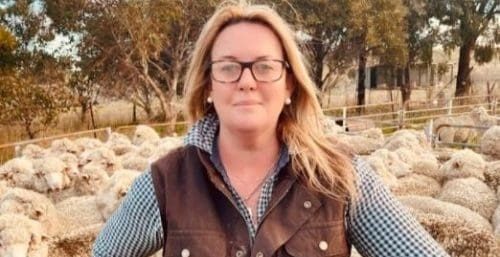
WoolProducers Australia CEO Jo Hall.
AUSTRALIAN Wool Innovation has said formal consultation on the next strategic plan with industry via the Woolgrower Consultation Group and Wool Industry Consultation Panel will begin in February.
But WoolProducers Australia chief executive officer Jo Hall has kickstarted the industry discussion with her latest blog, arguing it’s time for a new strategy on wool levy spending based less around marketing and more on research and development that addresses industry reality and on-farm viability.
A new strategy for a successful wool industry is needed
With the announcement of the WoolPoll results in November and growers again determining that 1.5 percent is the appropriate amount of levy they wish to allocate for research, development and marketing for the next three years, it is time for some new and bold thinking from Australian Wool Innovation.
AWI threw everything they had trying to convince growers to increase the levy to 2pc citing low reserves and predicted revenue for the next three years, with a tag line of ‘A successful wool industry needs 2pc’.
While no one is disputing that 1.5pc on reducing prices and volumes is making AWI’s income tight, the additional revenue generated by the 0.5pc that AWI was seeking would not have been the determining factor of having a successful or unsuccessful industry.
It is now incumbent for AWI to cut their cloth to fit their budget, just as growers have had to do and will have to continue to do until the market turns around. Let’s not forget that AWI chose to expend $148.2m over the past two-years while only receiving $128.3m for the same period. This is not living within their means and growers should not have been expected to pay a higher levy to bail them out.
The industry is suffering at the moment, and while we are all waiting and hoping for the promised upturn in the market there are things within AWI’s control that they can do now to assist wool growers.
Firstly, there needs to be some urgent acknowledgement from the board of AWI that there has to be a significant shift in the strategic direction of the operations of the company. At the post-AGM media briefing there was an opportunity for AWI to acknowledge that the persistent promotion of the activities that they have been conducting and those that they would undertake as outlined in the Voter Information Memorandum (VIM) if 2pc had been successful, simply did not resonate with growers.
Instead, AWI took the opportunity to blame tough seasonal, regulatory and market conditions along with adverse media coverage of the former CEO’s redundancy package for the outcome, while also choosing to highlight the so called ‘silver lining’ that there was an increase in first preference votes for 2pc in this WoolPoll compared to last time. I’m not so sure wool growers cared that that was the case, let alone that it was the one positive that AWI chose to focus on, because at the end of the day more than 60pv of votes cast did not support AWI’s recommendation – which is hardly something to crow about.
Secondly, there needs to be a change to the marketing versus research and development split. The 60:40 marketing to R&D ratio has been in place for over 10 years now, and with $365 million spent on marketing, it is safe to say that it is not yielding the results that would have been anticipated. The average Easter Market Indicator 10 years ago was 1099c/kg, and for the 2023-24 season it was 1155c/kg – this is not enough to keep people in the industry, particularly in light of increased input costs and labour challenges.
The focus on the weighting of marketing needs a serious rethink as it has been proven time and again that generic marketing does not work.
Given the wool market is exposed to so many external factors such as the Global Growth Index, which is reliant on major economies such as the US, China and Europe, which shows that generally when the index goes up so too does the price for wool and when it declines in times of global economic slumps so does wool.
There is also a lot of information provided by independent analysts, such as Mecardo and Episode 3, that proves that marketing has very little impact on the price paid for wool. In fact, one recent analysis suggested that marketing only accounts for about 12pc, given wool sale values move in line with global textile trends including synthetics and cotton.
While marketing and the promotion of wool is important, given that the actual price is driven by these other external factors and that wool is referred to as a discretionary spend, surely it makes more sense to expend a more significant portion of the compulsory levy on things that growers can control, such as on-farm R&D to make producers more efficient and extension to ensure widespread adoption.
The recent Agrista report commissioned by AWI, titled ‘Why stay in wool sheep?’ outlining reasons to stick with wool, showed that there is a big difference in farmgate returns between high performing producers and average producers through measuring financial and production performance, examining the feed supply curve and aligning energy demands, which are all things that growers can control – particularly if they are provided extension opportunities to learn and hone these skills.
Common sense would suggest that making wool growers more efficient to reduce cost of production to not only counter rising input costs and volatile prices but to actually turn a profit, would be a better spend of levies which may help halt the loss of hectares to competing industries and stem the exodus of growers from industry, which funnily enough would also assist AWI’s bottom line by maintaining and potentially increasing the number of levy payers. This strategy could be the start of having a successful industry on a 1.5pc levy.

Adjusted for inflation, in the last 25 years they have spent nearly $1.5 billion on marketing, to end up with the lowest wool price during that period and a wool clip 33 percent smaller. Meanwhile, production and harvest systems have not advanced. Well done.
I did hope someone would come up with something new. Well, here are four ideas.
1. Eliminate all waste and duplication by:
a. Ceasing funding promotion;
b. Ceasing funding of all education and training. In Australia education and training is either paid for by the State, the individual or the employer, not by an industry tax on gross income.
c. Ceasing funding to all the other “mickey mouse” projects including extension, except in specific cases of “extending” new research.
2. Create a new Wool Industry Research Council with a qualified research leader with the first objective to:
a. Create a new project team of young clever stud breeders who are at the cutting edge of creating the new Merino — non-mulesed with the desirable eating quality and wool characteristics with the objective of the Merino once again being the most profitable sheep breed in Australia. Aim for 80 percent of the Australian Merino flock certified non-mulesed by 2030.
3. Create a new project team to co-ordinate the centralization of all wool testing, storing and selling at one national centre in Australia.
4. Establish an internationally recognised institution, owned by the industry like AWTA to certify Australian wool for excellence in animal welfare and carbon sequestration.
All the levies from wool should be directed to Sheep Producers Australia and the National Farmers Federation.
The federal government should have nothing to do with our business. MLA the same.
It’s hard to know what to say; hasn’t it all been said before?
A good update from Jo.
On episode3.net, we have published numerous articles analysing the drivers of wool pricing – and it is largely economic conditions.
The levy in our view is not the issue, it is where it is spent.
Please, please, please listen to Ms Hall if you won’t listen to the rest of us. The AWI brand value has declined every year since 1990 in line with our terms of trade.
Congratulations Jo. You have obviously got it as they say.
As for AWI, it suffers from the same hang-up as the inventor who trying for something new keeps doing the same thing over and over, wondering why he gets the same result time after time.
Moving on should be the AWI catchcry.
Perfectly summed up. Cost of production is outstripping grower returns, hence why growers need to move out of the industry to keep going. The AWI leadership has lost the plot. Go and talk to wool growers and see for yourself what is happening with their bottomline and spend a day in a shed when shearing is taking place.